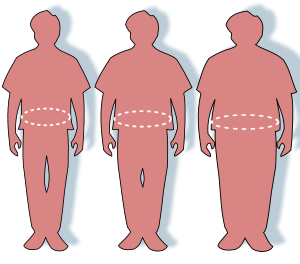 Image via Wikipedia
Image via WikipediaAs we age and approach menopause several factors begin to impede our ability to maintain our weight. Metabolism slows significantly after 40. Muscle mass can decrease as much as 10% every decade after 40. We become less active as aches and pains multiply.
Perhaps most significantly during menopause, a major shift in hormones occurs. Not only do the hot flashes and night sweats begin, these factors also contribute to an increase in belly fat in women. Belly fat or visceral fat is fat that is stored in the abdominal area. It surrounds major organs such as the heart, liver, pancreas, gallbladder and spleen. This type of fat leads to an increase in several health risks including: heart disease, diabetes, stroke and certain types of cancer such as breast and colorectal.
Studies indicate that changes in female hormones alter the way the body breaks down fat and stores it. After menopause stored fat can actually shift from the hips and thighs to the abdominal area. It is possible for some women to actually see an increase in their waist measurements without gaining any weight.
There are two fairly accurate measurements of visceral fat. The first is simply waist circumference. Hold a tape measure around the waist at the belly button, while standing up straight and breathing out. Women with a measurement of more than 35 inches are considered at high risk.
The second method is a waist to hip ratio. Divide the waist measurement by the hip measurement. A ratio of .85 places you in a high risk category.
The good news is visceral fat actually responds to exercise and diet better than subcutaneous fat (fat that is just under the skin).
To fight visceral fat requires a two pronged plan of attack. The first involves exercising for 30-60 minutes a day to burn calories. Interval training is especially helpful at reducing visceral fat. Strength training 2-4 times a week will help you maintain muscle mass. This added muscle will lead to an increase in your base metabolism, causing you to burn more calories while at rest.
Yoga and other exercise modalities that incorporate mind and body have been found to decrease stress. Stress hormones such as cortisol increase visceral fat storage. As an added benefit, studies show these activities may reduce menopausal symptoms including: hot flashes, sleep disturbances, fatigue, moodiness and night sweats.
The second prong is a diet that incorporates complex carbs such as fruits, veggies and whole grains combined with lean protein. Keeping a close eye on portion sizes and reducing sugar and saturated fats will keep you moving in the right direction.
The changes that come with age can be met and overcome. The sooner you start the better you will feel, while avoiding the debilitating effects of visceral fat.

4 comments:
It's important for menopausal women to always exercise and have proper nutrition so that they can combat belly fats.
Good day! This is my 1st comment here so I just wanted to
give a quick shout out and say I truly enjoy reading your articles.
Can you recommend any other blogs/websites/forums that go over the same topics?
Thanks!
Also visit my web blog ; website here
The Eat Right for Your Type diet was designed to help you achieve optimal health and your ideal weight. Its creator, Dr. Peter J. D’Adamo, believes in taking into consideration the uniqueness of each individual in designing a plan of healthy eating. The Premise The philosophy behind the Eat Right for Your Type diet is […] Diet Product Review
best electronic cigarettes, ecigs, smokeless cigarettes, buy electronic cigarette, ecigarette, electronic cigarette
Post a Comment